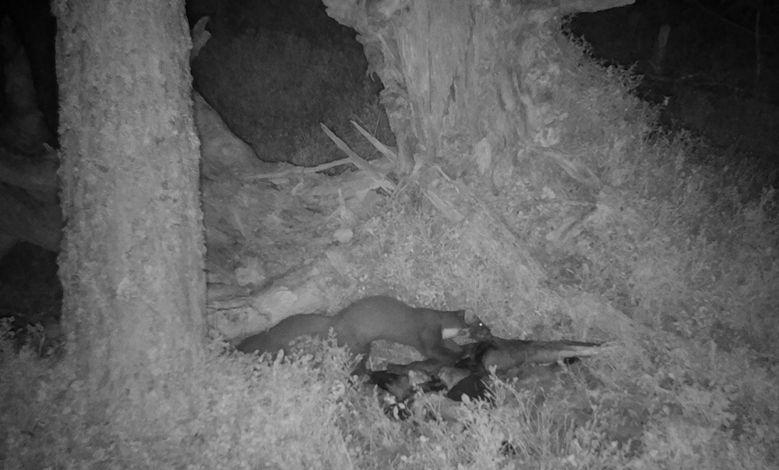
Xavier Lambin
@lambin-ecology.bsky.social
Academic population and conservation ecologist, working with mammals, birds, people and mentoring students and more experienced researchers. Chasing water and field voles, owls and other raptors, pine martens, capercaillie, wild living cats, mink and more
For 101 years, ecologists have sought to explain the 3-4 years multi-annual cycles of voles and lemmings. In our paper, doi.org/10.1073/pnas..., we find that Density-dependent recruitment, but not survival drives cyclic dynamics in a field vole population, overturning accepted wisdom.

October 5, 2025 at 3:26 PM
For 101 years, ecologists have sought to explain the 3-4 years multi-annual cycles of voles and lemmings. In our paper, doi.org/10.1073/pnas..., we find that Density-dependent recruitment, but not survival drives cyclic dynamics in a field vole population, overturning accepted wisdom.
Reposted by Xavier Lambin
New perspective out today in @jappliedecology.bsky.social.
We reflect on co-producing evidence in an effort to bridge the implementation gap, for evidence based, impact focused predator control.
What worked, what didn't and where barriers to implimentation still remain.
You can't win them all... 🧪
We reflect on co-producing evidence in an effort to bridge the implementation gap, for evidence based, impact focused predator control.
What worked, what didn't and where barriers to implimentation still remain.
You can't win them all... 🧪
besjournals.onlinelibrary.wiley.com
July 31, 2025 at 9:20 AM
New perspective out today in @jappliedecology.bsky.social.
We reflect on co-producing evidence in an effort to bridge the implementation gap, for evidence based, impact focused predator control.
What worked, what didn't and where barriers to implimentation still remain.
You can't win them all... 🧪
We reflect on co-producing evidence in an effort to bridge the implementation gap, for evidence based, impact focused predator control.
What worked, what didn't and where barriers to implimentation still remain.
You can't win them all... 🧪
Reposted by Xavier Lambin
🚨 New publication 📝
Out today in the royal society proceedings B. We find that diversionary feeding boosts productivity of cappercaille from 0.82 to 1.90. Indicating that this impact based method can effectively reduce the influence of predation.
Read all about it here: shorturl.at/QRb76
Out today in the royal society proceedings B. We find that diversionary feeding boosts productivity of cappercaille from 0.82 to 1.90. Indicating that this impact based method can effectively reduce the influence of predation.
Read all about it here: shorturl.at/QRb76

June 25, 2025 at 1:10 PM
🚨 New publication 📝
Out today in the royal society proceedings B. We find that diversionary feeding boosts productivity of cappercaille from 0.82 to 1.90. Indicating that this impact based method can effectively reduce the influence of predation.
Read all about it here: shorturl.at/QRb76
Out today in the royal society proceedings B. We find that diversionary feeding boosts productivity of cappercaille from 0.82 to 1.90. Indicating that this impact based method can effectively reduce the influence of predation.
Read all about it here: shorturl.at/QRb76
Reposted by Xavier Lambin
Great study led by Jaime Moyano, on how to slow down tree invasion from plantations in Patagonia. With @pablo-ecology.bsky.social, @barabara-langdon.bsky.social @anibalpauchard.bsky.social @martin-nunez.bsky.social @lambin-ecology.bsky.social
besjournals.onlinelibrary.wiley.com/doi/10.1111/...
besjournals.onlinelibrary.wiley.com/doi/10.1111/...

Remove saplings early: Cost‐effective strategies to contain tree invasions and prevent their impacts
Our highest-ranking strategies represent management actions to start implementing in the field as part of an adaptive management plan that iteratively evaluates the validity of our simulation model a...
besjournals.onlinelibrary.wiley.com
January 24, 2025 at 6:04 PM
Great study led by Jaime Moyano, on how to slow down tree invasion from plantations in Patagonia. With @pablo-ecology.bsky.social, @barabara-langdon.bsky.social @anibalpauchard.bsky.social @martin-nunez.bsky.social @lambin-ecology.bsky.social
besjournals.onlinelibrary.wiley.com/doi/10.1111/...
besjournals.onlinelibrary.wiley.com/doi/10.1111/...
Reposted by Xavier Lambin
I get to work with amazing people in our group, mostly extremely talented PhD students. Here is a starter pack with them all. Follow, and you wont be disappointed 🤩
go.bsky.app/HufyKhd
go.bsky.app/HufyKhd
January 2, 2025 at 11:47 AM
I get to work with amazing people in our group, mostly extremely talented PhD students. Here is a starter pack with them all. Follow, and you wont be disappointed 🤩
go.bsky.app/HufyKhd
go.bsky.app/HufyKhd
Reposted by Xavier Lambin
Here are the titles and links to the 10 fully #netgain PhD projects. Follow along for more exciting opportunities in 2025. 1/12

the words `` stay tuned '' are written in white spray paint on a black background surrounded by music notes .
ALT: the words `` stay tuned '' are written in white spray paint on a black background surrounded by music notes .
media.tenor.com
December 31, 2024 at 9:28 AM
Here are the titles and links to the 10 fully #netgain PhD projects. Follow along for more exciting opportunities in 2025. 1/12
Reposted by Xavier Lambin
This is work led by Amber Cowans (@ambercowans.bsky.social) and co-authored by Xavier Lambin (@lambin-ecology.bsky.social), and Darragh Hare.
All great people and worth a follow ☺️
All great people and worth a follow ☺️
December 8, 2024 at 12:23 PM
This is work led by Amber Cowans (@ambercowans.bsky.social) and co-authored by Xavier Lambin (@lambin-ecology.bsky.social), and Darragh Hare.
All great people and worth a follow ☺️
All great people and worth a follow ☺️
Reposted by Xavier Lambin
Funded PhD on using sighting data to identify breeding sites for predators and pollinators with a cool approach (geoprofiling) soon available with me and @deonroos.bsky.social, Lorraine Scott and @lambin-ecology.bsky.social, spread the word!
December 20, 2024 at 7:37 AM
Funded PhD on using sighting data to identify breeding sites for predators and pollinators with a cool approach (geoprofiling) soon available with me and @deonroos.bsky.social, Lorraine Scott and @lambin-ecology.bsky.social, spread the word!
Reposted by Xavier Lambin
TAKE HOME: We argue, using several strands of evidence, that diversionary feeding is a credible alternative to lethal control of predators and shows promising signs of reversing the decline of the capercaillie in Scotland.
Read the full paper here: www.biorxiv.org/content/10.1... 7/7
Read the full paper here: www.biorxiv.org/content/10.1... 7/7
December 14, 2024 at 4:43 PM
TAKE HOME: We argue, using several strands of evidence, that diversionary feeding is a credible alternative to lethal control of predators and shows promising signs of reversing the decline of the capercaillie in Scotland.
Read the full paper here: www.biorxiv.org/content/10.1... 7/7
Read the full paper here: www.biorxiv.org/content/10.1... 7/7
Reposted by Xavier Lambin
RESULT: Diversionary feeding increased the number of hens detected with chicks, consistent with our previous work showing a decrease in nest failure. This resulted in productivity (the expected chicks per hen) increasing from 0.82 in unfed sites to 1.9 in fed sites (more than double!). 6/7

December 14, 2024 at 4:43 PM
RESULT: Diversionary feeding increased the number of hens detected with chicks, consistent with our previous work showing a decrease in nest failure. This resulted in productivity (the expected chicks per hen) increasing from 0.82 in unfed sites to 1.9 in fed sites (more than double!). 6/7
Reposted by Xavier Lambin
HYPOTHESIS: Using a 3-year landscape-scale control-treatment experiment, we predicted that the chicks per hen differed between sites that deployed diversionary feeding and sites that did. 5/7

December 14, 2024 at 4:43 PM
HYPOTHESIS: Using a 3-year landscape-scale control-treatment experiment, we predicted that the chicks per hen differed between sites that deployed diversionary feeding and sites that did. 5/7
Reposted by Xavier Lambin
METHOD: We used #cameratraps on dust baths, natural features used by capercaillie, to detect capercaillie hens and determine whether they had chicks or didn’t have chicks. We used #AI from conservation ai to detect and count hens and broods. 4/7

December 14, 2024 at 4:43 PM
METHOD: We used #cameratraps on dust baths, natural features used by capercaillie, to detect capercaillie hens and determine whether they had chicks or didn’t have chicks. We used #AI from conservation ai to detect and count hens and broods. 4/7
Reposted by Xavier Lambin
BACKGROUND: Previously, we found that DF reduced artificial nest depredation, resulting in an 83% increase in nest survival. The big question though was whether this would translate to real birds. 3/7

December 14, 2024 at 4:43 PM
BACKGROUND: Previously, we found that DF reduced artificial nest depredation, resulting in an 83% increase in nest survival. The big question though was whether this would translate to real birds. 3/7
Reposted by Xavier Lambin
All research wouldn't be possible without my fantastic co-authors: @lambin-ecology.bsky.social, @chrissuthy.bsky.social and @kennyafc.bsky.social l!! 🙏
2/7
2/7
December 14, 2024 at 4:43 PM
All research wouldn't be possible without my fantastic co-authors: @lambin-ecology.bsky.social, @chrissuthy.bsky.social and @kennyafc.bsky.social l!! 🙏
2/7
2/7
Reposted by Xavier Lambin
⏰New Research ⏰
We quantified the direct impact of diversionary feeding on capercaillie productivity. We show an increase in the proportion of hen with a brood in DF sites (37% -> 85%) and, as a result, a 131% increase in chicks per hen. Read more here: www.researchgate.net/publication/...
1/7
We quantified the direct impact of diversionary feeding on capercaillie productivity. We show an increase in the proportion of hen with a brood in DF sites (37% -> 85%) and, as a result, a 131% increase in chicks per hen. Read more here: www.researchgate.net/publication/...
1/7

December 14, 2024 at 4:43 PM
⏰New Research ⏰
We quantified the direct impact of diversionary feeding on capercaillie productivity. We show an increase in the proportion of hen with a brood in DF sites (37% -> 85%) and, as a result, a 131% increase in chicks per hen. Read more here: www.researchgate.net/publication/...
1/7
We quantified the direct impact of diversionary feeding on capercaillie productivity. We show an increase in the proportion of hen with a brood in DF sites (37% -> 85%) and, as a result, a 131% increase in chicks per hen. Read more here: www.researchgate.net/publication/...
1/7
Join us as @QUADRATdtp PhD candidate to learn and research population dynamics, demography and dispersal, working with lovely Tawny owls,
with @Paulcaplat.bsky.social, @Chrissuthy.bsky.social and my brilliant, supportive, interactive team within UoABioSci
findaphd.com/phds/project/q…
with @Paulcaplat.bsky.social, @Chrissuthy.bsky.social and my brilliant, supportive, interactive team within UoABioSci
findaphd.com/phds/project/q…

November 25, 2023 at 7:25 PM
Join us as @QUADRATdtp PhD candidate to learn and research population dynamics, demography and dispersal, working with lovely Tawny owls,
with @Paulcaplat.bsky.social, @Chrissuthy.bsky.social and my brilliant, supportive, interactive team within UoABioSci
findaphd.com/phds/project/q…
with @Paulcaplat.bsky.social, @Chrissuthy.bsky.social and my brilliant, supportive, interactive team within UoABioSci
findaphd.com/phds/project/q…

